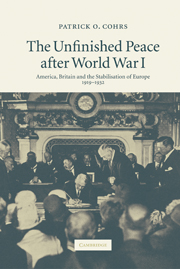Book contents
- Frontmatter
- Contents
- Acknowledgements
- List of abbreviations
- A note on the footnotes and bibliography
- Introduction
- Prologue
- 1 The wider challenges
- 2 Wilson, Lloyd George and the quest for a ‘peace to end all wars’
- 3 The ill-founded peace of 1919
- 4 The escalation of Europe's post-Versailles crisis, 1920–1923
- Part I The Anglo-American stabilisation of Europe, 1923–1924
- Part II Europe's nascent Pax Anglo-Americana, 1924–1925
- 11 The dawning of a Progressive Pax Americana in Europe?
- 12 Towards the Locarno pact
- 13 Regression?
- 14 Beyond irreconcilable differences?
- 15 The path to Locarno – and its transatlantic dimension
- 16 The second ‘real’ peace settlement after World War I
- Part III The unfinished transatlantic peace order: the system of London and Locarno, 1926–1929
- Epilogue
- Conclusion
- Map: Post-World War I Europe after the peace settlement of Versailles
- Bibliography
- Index
11 - The dawning of a Progressive Pax Americana in Europe?
Published online by Cambridge University Press: 21 July 2009
- Frontmatter
- Contents
- Acknowledgements
- List of abbreviations
- A note on the footnotes and bibliography
- Introduction
- Prologue
- 1 The wider challenges
- 2 Wilson, Lloyd George and the quest for a ‘peace to end all wars’
- 3 The ill-founded peace of 1919
- 4 The escalation of Europe's post-Versailles crisis, 1920–1923
- Part I The Anglo-American stabilisation of Europe, 1923–1924
- Part II Europe's nascent Pax Anglo-Americana, 1924–1925
- 11 The dawning of a Progressive Pax Americana in Europe?
- 12 Towards the Locarno pact
- 13 Regression?
- 14 Beyond irreconcilable differences?
- 15 The path to Locarno – and its transatlantic dimension
- 16 The second ‘real’ peace settlement after World War I
- Part III The unfinished transatlantic peace order: the system of London and Locarno, 1926–1929
- Epilogue
- Conclusion
- Map: Post-World War I Europe after the peace settlement of Versailles
- Bibliography
- Index
Summary
In a narrower sense, the pre-history of Locarno began with the implementation of the Dawes plan in the autumn of 1924. For it changed the wider international ‘playing-field’ on which the reorganisation of European security politics in the mid-1920s took place. To a considerable extent, it became a ‘playing-field’ determined, and delimited, by the American endeavour to make the Dawes system into a cornerstone of what in Republican thinking emerged as a Progressive Pax Americana for Europe.
In concrete terms, once the German parliament had passed the requisite laws, two agreements remained to be finalised to launch the new reparations regime. First, the European allies and the United States, as ‘associated power’, had to agree on the division of German payments under the Dawes scheme. This was accomplished at the Paris conference of September 1924. The Coolidge administration's core interest was to be reimbursed for army costs that Germany ‘was obligated to pay’ under the 1921 Treaty of Berlin. In short, the Paris agreement fixed inter-allied reparations shares without much controversy and US army-cost payments to Washington's satisfaction. At the same time, the United States remained a power unbridled by the provisions of 1919, not ‘committed morally or legally’ to enforce ‘the collection of reparations from Germany’. Further, and more importantly, the western governments and Anglo-American bankers had to reach a consensus on the final modalities of the Dawes loan to Germany. This eventually emerged at a meeting in London in mid-October.
- Type
- Chapter
- Information
- The Unfinished Peace after World War IAmerica, Britain and the Stabilisation of Europe, 1919–1932, pp. 187 - 200Publisher: Cambridge University PressPrint publication year: 2006



